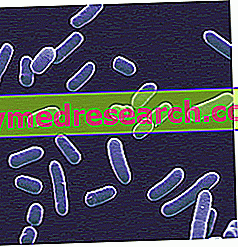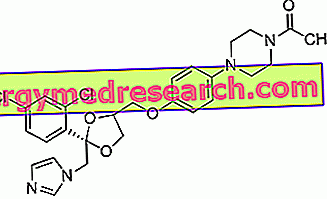Generality
Haemophilus influenzae is a bacterium responsible for infectious diseases localized preferentially to the respiratory tract and to the meninges. Small gram-negative bacterium, immobile, asporiginal, aerobic facultative, not acid-resistant, coconut-shaped but with peliomorphism, hence the ability to modify its morphology if necessary, Haemophilus influenzae owes its name to the error of to have been initially recognized as the body responsible for the flu, which we now know to have a viral origin.

Diseases sustained by Haemophilus influenzae
Haemophilus influenzae is a poorly invasive pathogen, peculiar to human beings, which usually colonizes the mucous membranes of the first airways of many adults, especially in the winter months, without causing particular diseases. Although it is found in 80% of healthy adults, as a rule the infection is circumscribed by the immune system and starts asymptomatically. When the body's defense lines are compromised by particular conditions (immunocompromise, intercurrent diseases, bad environmental conditions), Haemophilus influenzae becomes pathogenic, causing mainly local infections (upper and lower airways) and in more serious systemic cases.
The frequency of pathological infection with Haemophilus influenzae is inversely proportional to age; this means that the bacterium mainly attacks children, so that in the absence of vaccination at least 50% of the pediatric population suffers an infection with Haemophilus influenzae in the first year of life and almost all the children have already been infected at three years. Even the elderly offer less resistance to infection.
Type B - Infections in the child
Haemophilus influenzae may or may not be equipped with a polysaccharide capsule (LPS). Among the bacteria that exhibit this virulence factor, 6 antigenic types are currently known, identified from the first six letters of the alphabet, from a) to f). Among these, Haemophilus influenzae type B is the most widespread in human pathology, has an invasive tendency, is often associated with bacteremia and affects predominantly neonates and children under the age of two. The danger of this bacterium in children has stimulated research for a specific vaccine, available for some years now, to be administered for the first time at the age of two months. Bacteria lacking a polysaccharide capsule are called non-typeable Haemophilus influenzae .
As anticipated, the infection with Haemophilus influenzae type B is dangerous especially in pediatric age, so that before the introduction of the vaccine, the microorganism represented the most common cause of bacterial meningitis from two months to five years of age. The inflammation of the meninges caused by Haemophilus influenzae is the most serious clinical form of the infection since it can cause rather serious damages with serious handicaps located above all in the nervous system: deafness and blindness, problems of learning and development, brain damage in general . The disease is rare in adults over 27 years. The symptomatic onset of purulent meningitis from Haemophilus influenzae is abrupt, although the onset of meningitis is often preceded by symptoms localized to the airways (nasopharyngitis, bronchitis, bronchopneumonia) or ear (otitis), foci that - especially in the absence of adequate treatment - they represent the entry gates of the pathogen for blood circulation (septicemia) and from here to the meninges. Fever, difficulty breathing, sore throat, pain on swallowing, overproduction of saliva are the initial symptoms of meningitis. The evolution can be dramatic, with the spread of the bacterium by blood (septicemia) and multi-organ involvement with patient death.
The bacterium Haemophilus influenzae can also cause a serious throat infection in the laryngeal area (of the vocal cords). This infection is called acute epiglottitis. Due to its explosive symptomatology, if not readily recognized and treated, this manifestation is potentially fatal, because it prevents the child from breathing normally. The acute epiglottitis manifests itself with sore throat, fever, and shortness of breath, increasingly suffocating until the respiratory obstruction; not surprisingly, acute epiglottitis is also known as acute choking laryngitis.
Infections with Haemophilus influenzae strains that cannot be typified
While infections sustained by enveloped serotype b strains are mainly pediatric, infections with non-typeable Haemophilus influenzae strains are common in adults, particularly in immunocompromised subjects (immunosuppressive therapies, AIDS, hemodialysis) and in those with chronic obstructive bronchitis ( COPD) or other chronic lung diseases. Furthermore, they are frequently found in the lower respiratory tract of patients with cystic fibrosis during episodes of exacerbation of the disease. The infection can localize at various levels of the airways and ear, directly causing otitis media, tonsillitis, acute sinusitis, pharyngitis (sore throat), tracheitis, tracheobronchitis, chronic bronchitis, pleurisy and / or pneumonia, or exacerbating the same when caused by other etiological agents (viruses and bacteria). Haemophilus influenzae infections generally have a purulent character, so they are associated with the production of pus.
Rare types of Haemophilus influenzae that can not be typed give invasive forms, extending bloodly to other parts of the body: septic arthritis, pericarditis, endocarditis, cholecystitis, cellulitis, purulent arthritis, urinary infections, empyema and epiglottitis in adults, puerperal sepsis and septicemia in the newborn.
Diagnosis, treatment and vaccination
Before clinical suspicion, bacteriological confirmation is required, for example by culture test on the biological sample that best reflects the location of the infectious focus: aspirated from the sinuses (sinusitis), phlegm or sputum (airway diseases), cerebrospinal fluid and blood (purulent meningitis), skin and blood (cellulite), tympanocentesis aspirate (otitis media), blood and joint aspirate (arthritis).
Currently, the treatment of choice for Haemophilus influenzae infections is based on the use of third-generation cephalosporins, such as ceftriazone (2g / day in adults) and cefotaxime (2g three times / day), elective drugs in severe cases (like purulent bacterial meningitis). Therapy should be continued for 7-14 days and completed even in the presence of a marked improvement in symptoms. For less severe cases, it is preferred to use a different antibiotic combination: ampicillin and sulbactam, second cephalosporins (cefaclor, cefamandolo and cefuroxime) and third generation, or fluoroquinolones.
Vaccine
For preventive purposes, for some years now specific vaccines have been available consisting of the capsular polysaccharide of Haemophilus influenzae type B, generally combined with other components that ensure immunity against other diseases, such as diphtheria, tetanus, pertussis, poliomyelitis and hepatitis B (see the pharmaceutical product Infanrix Hexa). Inoculation of the vaccine generally occurs for the first time at the age of two months. Three other vaccinations are then necessary: at four months, at six months and at 12-18 months.
By completing the entire course of vaccinations, the serum protects approximately 95 percent of children against serious infections with Haemophilus influenzae type B: it is instead totally ineffective in preventing meningitis caused by other bacteria.
In cases of contact with infected subjects, chemoprophylaxis with rifampicin is feasible in children and adults who have not yet experienced the symptoms of infection.
Mandatory
With the decree-law on vaccination prevention for minors from zero to 16 years, approved on 05/19/2017 the vaccine against Haemophilus influenzae has become mandatory for those born since 2001 .
Moreover, always in the key of protection from meningitis:
- those born between 2012 and 2016 are required to carry out vaccination also against meningococcus C.
- those born in 2017 are required to carry out vaccination also against meningococcus C and meningococcus B.
For more information on mandatory vaccines in children, see this article.



